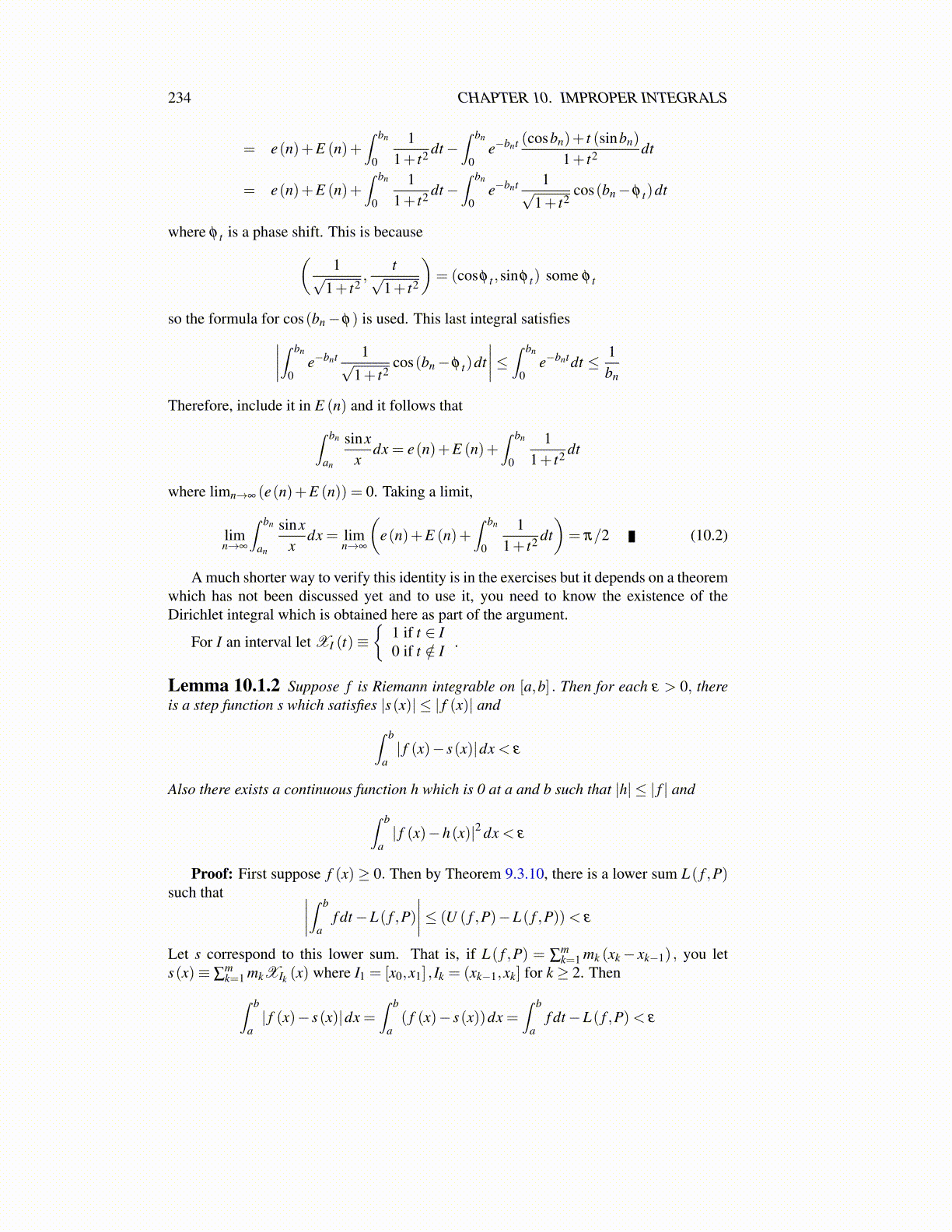
234 CHAPTER 10. IMPROPER INTEGRALS
10.2 ConvergenceThe pointwise convergence of Fourier series was first successfully shown by Dirichlet in1829. Here this important result, discussed later, is obtained from the very remarkableRiemann Lebesgue lemma.
Theorem 10.2.1 The following hold
1.∫
∞
0sinu
u du = π
2 =∫
∞
0sin(ru)
u du for any r > 0
2. limr→∞
∫∞
δ
sin(ru)u du = 0 whenever δ > 0.
3. If f ∈ L1 (R) , then limr→∞
∫∞
−∞sin(ru) f (u)du = 0. Note this implies that for any
finite interval, [a,b] ,
limr→∞
∫ b
asin(ru) f (u)du = 0.
You just apply the first part to the function which is extended as 0 off [a,b].
Proof: The first part 1. is Lemma 10.1.1.Next consider 2. First note that
∫∞
0sin(ru)
u du =∫
∞
0sin(t)
t r 1r dt =
∫∞
0sin(t)
t dt.Now considerthe truncated integral
∫∞
δ
sin(ru)u du. It equals
∫∞
0sin(ru)
u du−∫
δ
0sin(ru)
u du which can be seenfrom the definition of what the improper integral means. Also, you can change the variable.Let ru = t so rdu = dt and the above reduces to∫
∞
0
sin(t)t
r1r
dt−∫ rδ
0
sin(t)t
dt =∫
∞
δ
sin(ru)u
du
Thus π
2 −∫ rδ
0sin(t)
t dt =∫
∞
δ
sin(ru)u du and so limr→∞
∫∞
δ
sin(ru)u du = 0 from the first part.
Now consider the third claim, the Riemann Lebesgue lemma. Then for f ∈ L1, letfR,r (t)≡X[−r,R] (t) f (t). Then for R,r large,∫
∞
−∞
| f (t)− fR,r (t)|dt =∫
∞
R| f (t)|dt +
∫ −r
−∞
| f (t)|dt < ε (10.3)
Now fR,r is Riemann integrable and so there is a step function s(t) = ∑ni=1 aiXIi (t) such
that |s(t)| ≤ | fR,r (t)| and∫ R
−r| fR,r (t)− s(t)|dt =
∫∞
−∞
| fR,r (t)− s(t)|dt < ε (10.4)
This follows from Lemma 10.1.2. From 10.4 and 10.3,∫
∞
−∞|s(t)− f (t)|dt < 2ε. Now∣∣∣∣∫ ∞
−∞
f (t)sin(rt)dt∣∣∣∣ ≤ ∫
∞
−∞
|( f (t)− s(t))sin(rt)|dt +∣∣∣∣∫ ∞
−∞
s(t)sin(rt)dt∣∣∣∣
≤ 2ε +
∣∣∣∣∫ ∞
−∞
s(t)sin(rt)dt∣∣∣∣ (10.5)
It remains to verify that limr→∞
∫∞
−∞s(t)sin(rt)dt = 0. Since s(t) is a sum of scalars times
XI for I an interval, it suffices to verify that limr→∞
∫∞
−∞X[a,b] (t)sin(rt)dt = 0 How-
ever, this integral is∫ b
a sin(rt)dt = −1r cos(rb)+ 1
r cos(ra) which clearly converges to 0